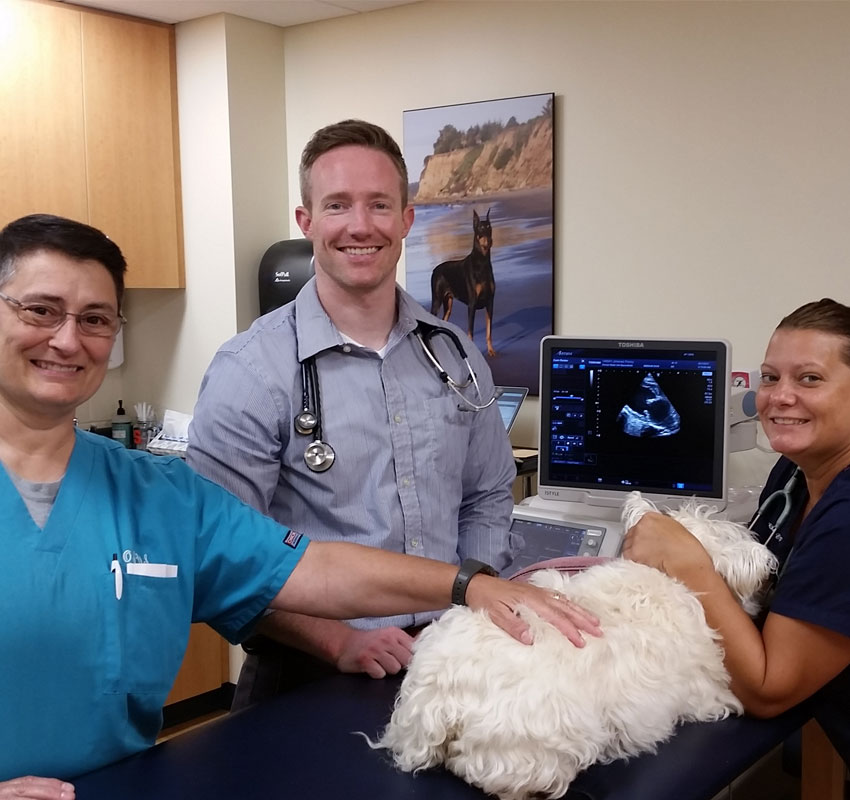The Role of Ultrasound and CT Scan in Modern Vet Practices: Insights From Experienced Professionals
In modern-day vet methods, ultrasound and CT scans greatly improve diagnostic capacities. These imaging methods offer essential insights into animal health, guiding treatment decisions. Experienced professionals identify the one-of-a-kind advantages of each method. Ultrasound uses real-time analyses, while CT checks deliver complex anatomical information. Understanding their roles and applications elevates important questions about their influence on patient end results and the future of vet diagnostics. What understandings can be acquired from their combined use?
Understanding Ultrasound in Vet Medication
Ultrasound is an important analysis tool in veterinary medicine, offering a non-invasive method to picture inner frameworks. This imaging technique utilizes high-frequency audio waves to create real-time photos of tissues and organs, enabling vets to assess problems without surgical treatment. Typical applications include reviewing the heart, liver, kidneys, and reproductive body organs, in addition to monitoring pregnancies.The procedure is fairly quick and can be executed in various settings, making it an easily accessible option for veterinarians. Unlike radiography, ultrasound supplies detailed info regarding soft cells and blood flow, which is important for exact diagnoses.Veterinary experts depend on ultrasound to identify irregularities such as tumors, cysts, and liquid accumulation. Its ability to assist biopsies and various other procedures additionally enhances its energy in medical practice. By using a reliable and safe method to analyze interior anatomy, ultrasound has actually come to be a cornerstone of modern vet diagnostics.
The Benefits of CT Checks for Pet Diagnostics
CT checks offer significant benefits in veterinary diagnostics by supplying improved accuracy in identifying interior conditions (Cancer Veterinary Near Me). As a non-invasive imaging strategy, they ensure the safety and convenience of pets throughout assessments. Furthermore, CT scans facilitate a complete analysis of internal structures, permitting a lot more effective treatment planning
Boosted Analysis Accuracy
Advancements in imaging modern technology have considerably enhanced analysis accuracy in vet medication, specifically via using CT scans. These scans give thorough cross-sectional photos of a pet's inner structures, permitting vets to recognize problems with precision. The high resolution and three-dimensional capabilities of CT imaging promote the discovery of conditions such as growths, fractures, and internal bleeding that might be missed out on with traditional imaging approaches. Furthermore, CT scans can aid in pre-surgical planning by using a comprehensive sight of physiological partnerships. This level of detail not only enhances the accuracy of diagnoses yet likewise help in customizing reliable treatment strategies. Consequently, the assimilation of CT innovation right into veterinary techniques is transforming the landscape of animal healthcare, enhancing outcomes for individuals.
Non-Invasive Imaging Method
The introduction of non-invasive imaging strategies has reinvented animal diagnostics, with CT checks becoming a prominent tool in veterinary techniques. These scans offer high-resolution, cross-sectional photos of an animal's internal frameworks, enabling vets to evaluate complex conditions without the demand for intrusive treatments. The benefits of CT scans include their ability to discover lumps, cracks, and inner blood loss with amazing accuracy. Furthermore, they assist in the assessment of soft tissues and body organs, enhancing diagnostic capabilities. The speed of CT scanning allows quick decision-making, which is important in emergency situations. By reducing tension and discomfort for the pet, CT scans add to a much more gentle technique to diagnostics, ultimately improving therapy end results and advancing veterinary care.
Comprehensive Internal Assessment
A comprehensive interior analysis is necessary for precise medical diagnosis and efficient treatment in veterinary medicine. CT checks deal substantial advantages hereof, offering detailed cross-sectional pictures of a pet's internal structures. This sophisticated imaging technique improves visualization of complicated physiological regions, making it possible for veterinarians to recognize problems such as tumors, fractures, and internal blood loss with better accuracy. Additionally, CT checks help with the evaluation of conditions that may be challenging to diagnose with standard methods. The speed and precision of CT imaging additionally add to timely treatments, improving individual end results. As veterinary methods increasingly incorporate CT innovation, the advantages of extensive interior analyses end up being obvious, reinforcing the importance of this device in modern-day vet diagnostics.
Comparing Ultrasound and CT Imaging Techniques
While both ultrasound and CT imaging offer important roles in veterinary diagnostics, each method provides unique benefits and limitations that can affect medical decision-making. Ultrasound is specifically valued for its real-time imaging capacities, allowing vets to observe vibrant physiological processes. This method is non-invasive, mobile, and does not entail ionizing radiation, making it a more secure alternative for both medical professionals and animals. Ultrasound might have limitations in visualizing specific physiological structures or deep tissues.Conversely, CT imaging gives in-depth cross-sectional sights of the body, allowing for precise localization of abnormalities. It masters reviewing facility body organs and structures, especially in the thorax and abdominal area. CT scans require sedation or anesthesia in lots of cases and entail exposure to ionizing radiation. Ultimately, the choice in between ultrasound and CT relies on the details scientific circumstance, the area of passion, and the seriousness of the diagnostic requirements.
Instance Studies: Effective Diagnoses With Imaging
Situation studies illustrate the substantial renovations in analysis precision attained via sophisticated imaging innovations like ultrasound and CT scans in vet techniques. These innovations not just boost the discovery of numerous problems however likewise help with timely and effective therapy plans. Examining certain cases can highlight the transformative impact of these imaging techniques on veterinary medication.
Analysis Accuracy Improvements

Imaging Innovation Advancements
As veterinary imaging modern technology remains to progress, its influence on diagnostic capabilities comes to be significantly obvious. Current study highlight the successful application of innovative ultrasound and CT scan methods in determining complicated conditions. For circumstances, a vet clinic used high-resolution CT scans to identify a rare kind of lung cancer in a pet, which conventional imaging had missed out on. An ultrasound assessment revealed a stomach mass in a feline, motivating prompt medical treatment and a favorable outcome. These improvements not only improve diagnostic precision but likewise allow vets to develop targeted therapy strategies. By leveraging sophisticated imaging modern technologies, vet experts are markedly improving patient care, resulting in much more effective monitoring of various wellness problems in animals.
The Role of Imaging in Emergency Situation Veterinary Care
Imaging plays an important role in emergency situation vet treatment, offering vets with essential info required to make fast, enlightened decisions. In immediate circumstances, methods like ultrasound and CT scans enable specialists to promptly analyze an animal's internal structures, identifying important problems such as internal bleeding, cracks, or organ abnormalities. These imaging techniques permit real-time examinations, promoting prompt interventions that can be life-saving. For instance, ultrasound is indispensable for evaluating soft tissue injuries and problems like fluid buildup, while CT checks offer detailed pictures of complex physiological structures, crucial for identifying trauma cases. The speed and precision of these imaging strategies enhance the vet's ability to design effective therapy strategies, making certain the very best feasible end results for their people. The assimilation of innovative imaging technologies into emergency situation veterinary practices is not only advantageous but significantly essential, as it boosts diagnostic capabilities and boosts total pet treatment throughout important moments.

Training and Expertise in Vet Imaging
Although sophisticated imaging methods such as ultrasound and CT scans are crucial for efficient vet care, the effective implementation of these innovations heavily relies on the training and proficiency of vet experts. Efficient use of imaging tools calls for detailed expertise of composition, pathology, and the principles underlying each technique. Veterinary experts should go through specific training to properly translate imaging outcomes, which is important for identifying conditions and planning treatment.Certifications and proceeding education and learning in vet imaging improve the skills of specialists, allowing them to remain upgraded with technological developments. Cooperation between radiologists and vets typically results in boosted diagnostic accuracy, as experts can supply insights into complex instances. Furthermore, useful experience in handling imaging equipment cultivates confidence in its application. Inevitably, the high quality of veterinary imaging services is straight correlated to the degree of training and expertise possessed by the specialists making redirected here use of these important this hyperlink analysis devices.
Future Patterns in Diagnostic Imaging for Animals
With the quick improvements in innovation, veterinary analysis imaging is poised for substantial advancement in the coming years. Emerging patterns suggest a shift in the direction of even more mobile and accessible imaging techniques, such as portable ultrasound gadgets, which can enhance area diagnostics. Additionally, the assimilation of synthetic knowledge is anticipated to reinvent photo analysis, permitting quicker and a lot more accurate analyses of results.Moreover, innovations in 3D imaging strategies and computed tomography will certainly supply vets with more comprehensive sights of pet composition, leading to enhanced therapy strategies. Digital fact innovation may also contribute in surgical planning and education and learning, giving veterinarians an one-of-a-kind perspective on complicated cases.As telemedicine proceeds to expand, remote examinations helped with by diagnostic imaging will certainly become more common, enabling specialists to aid general professionals in real-time. On the whole, these fads are readied to improve the performance and efficiency of veterinary care, inevitably improving animal end results.
Frequently Asked Concerns
Just How Much Do Ultrasound and CT Scans Price in Vet Clinics?
The expenses of ultrasound and CT scans in vet centers commonly range from $300 to $1,500, relying on variables such as location, clinic type, and particular procedures required for the animal's medical diagnosis and therapy.

Are There Any Type Of Dangers Related To Ultrasound and CT Scans for Pet Dogs?
Ultrasound and CT scans usually pose minimal threats to pet dogs. However, prospective concerns consist of sedation responses and exposure to anesthetics. Board Certified Veterinary Cardiologist. Vets carefully assess each situation to mitigate any dangers connected with these analysis treatments
How Much Time Do Ultrasound and CT Treatments Typically Take?
Ultrasound treatments generally take about 30 mins to an hour, depending on the intricacy. CT scans, being more detailed, normally call for half an hour to 90 mins, consisting of preparation and healing time for the pet dog.
Can All Veterinarians Perform Ultrasounds and CT Scans?
Not all veterinarians can perform ultrasounds and CT scans. Specialized training and certification are typically called for to guarantee competency in these sophisticated imaging techniques, which might restrict their availability to veterinarians with added qualifications and sources.
What Kinds of Pets Benefit A Lot Of From These Imaging Techniques?
Particular animal species, particularly cats and canines, advantage greatly from ultrasound and CT scans. These imaging methods improve diagnostic accuracy for problems like lumps, internal injuries, and body organ irregularities, leading to improved therapy outcomes and patient treatment. The high resolution and three-dimensional abilities of CT imaging facilitate the detection of conditions such as lumps, cracks, and inner blood loss that might be missed with conventional imaging approaches. Case researches illustrate the significant enhancements in diagnostic accuracy accomplished with sophisticated imaging technologies like ultrasound and blog CT scans in veterinary practices. Improving diagnostic precision in vet practices has been substantially helped by advancements in imaging technologies such as ultrasound and CT scans. Sophisticated imaging techniques such as ultrasound and CT scans are vital for effective veterinary treatment, the effective application of these innovations greatly depends on the training and know-how of veterinary experts. Vet specialists need to go through specific training to accurately interpret imaging outcomes, which is crucial for diagnosing problems and preparing treatment.Certifications and continuing education in vet imaging improve the abilities of experts, allowing them to remain upgraded with technical improvements.
Comments on “What Are CT Scans For Animals, and When Are They Needed?}”